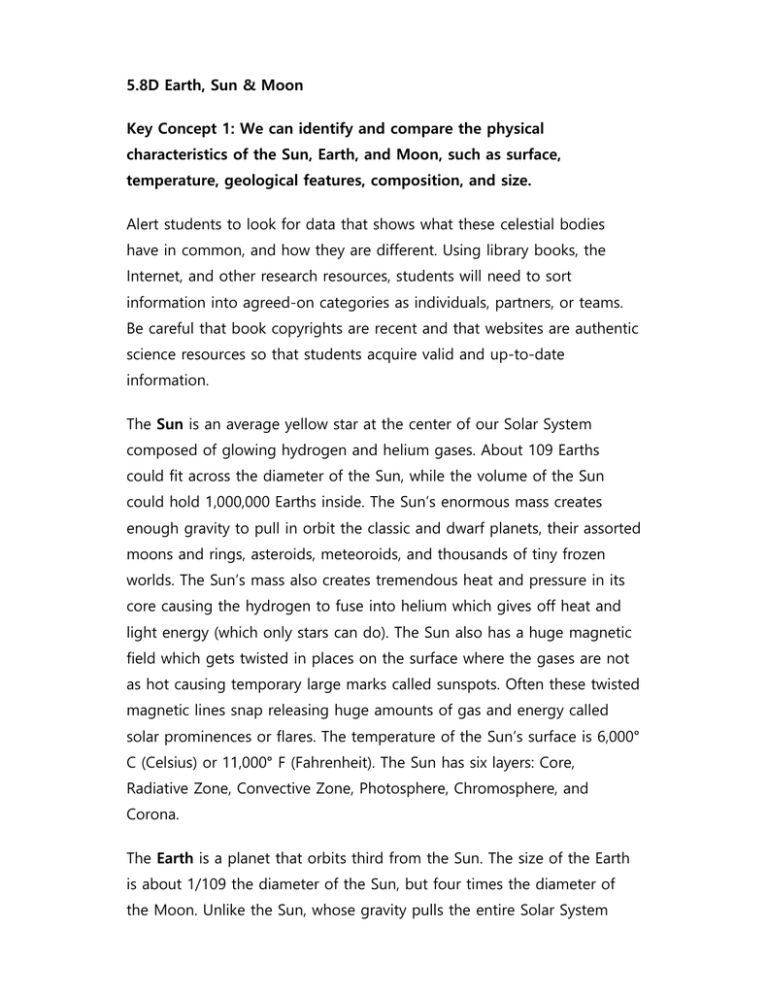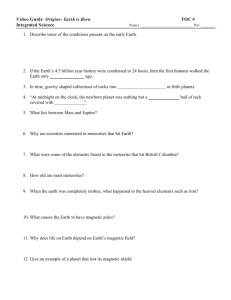5.8D Key Concepts - Rooster 5
advertisement

5.8D Earth, Sun & Moon Key Concept 1: We can identify and compare the physical characteristics of the Sun, Earth, and Moon, such as surface, temperature, geological features, composition, and size. Alert students to look for data that shows what these celestial bodies have in common, and how they are different. Using library books, the Internet, and other research resources, students will need to sort information into agreed-on categories as individuals, partners, or teams. Be careful that book copyrights are recent and that websites are authentic science resources so that students acquire valid and up-to-date information. The Sun is an average yellow star at the center of our Solar System composed of glowing hydrogen and helium gases. About 109 Earths could fit across the diameter of the Sun, while the volume of the Sun could hold 1,000,000 Earths inside. The Sun’s enormous mass creates enough gravity to pull in orbit the classic and dwarf planets, their assorted moons and rings, asteroids, meteoroids, and thousands of tiny frozen worlds. The Sun’s mass also creates tremendous heat and pressure in its core causing the hydrogen to fuse into helium which gives off heat and light energy (which only stars can do). The Sun also has a huge magnetic field which gets twisted in places on the surface where the gases are not as hot causing temporary large marks called sunspots. Often these twisted magnetic lines snap releasing huge amounts of gas and energy called solar prominences or flares. The temperature of the Sun’s surface is 6,000° C (Celsius) or 11,000° F (Fahrenheit). The Sun has six layers: Core, Radiative Zone, Convective Zone, Photosphere, Chromosphere, and Corona. The Earth is a planet that orbits third from the Sun. The size of the Earth is about 1/109 the diameter of the Sun, but four times the diameter of the Moon. Unlike the Sun, whose gravity pulls the entire Solar System around it, only one moon revolves around Earth. Unlike the Sun, the Earth and Moon do not give off their own heat and light, but reflect sunlight. The Earth is 93,000,000 miles from the Sun, which is just the right distance where water can exist naturally in three forms: solid ice mainly at polar regions; liquid water in streams, rivers, ponds, lakes and oceans that cover ¾ of the Earth’s surface; and gas (water vapor) in our atmosphere. Unlike the Sun and Moon, Earth has life and water in all three states. Unlike the Sun which is a glowing ball of gas, Earth is rocky and made of three major layers: core, mantle and crust. The rigid outer mantle and the crust make up a layer that is broken into massive plates that move very slowly causing the surface of our Earth to form a diverse assortment of landforms such as continents, mountains, volcanoes, etc. New surface is created on the ocean floor, while old surface plates get pushed down elsewhere. Erosion constantly sculptures old landforms and creates new ones. Unlike the Moon, which has no measurable atmosphere, the Earth has a thin atmosphere made of a thin mixture of nitrogen and oxygen (produced by plants), whereas the Sun is made entirely of hot gas. The temperature range on Earth varies from -89° C to 57° C (-128.2° F to 134.6° F). The Moon is the Earth’s only natural satellite. Planet Earth is the first inner planet to have a moon (Mercury and Venus have no moons). Earth is the only planet to have just one moon; Mars has two moons and the gas giants have huge numbers of moons. The Moon is ¼ the diameter of Earth, has 1/6 the gravity of Earth, and orbits the Earth once a month (about every 29 days). The surface of the Moon shines by reflected sunlight as does the Earth. However, because the Moon revolves around the Earth and changes its angular position between the Earth and the Sun, different amounts of sunlight illuminate the Moon during the month creating different phases of the moon (studied in 4th grade). The Moon’s surface is covered in dusty soil, craters, and lava flows (Mare) caused by ancient meteorite impacts because there is no atmosphere to weather or erode the surface. The Earth, in contrast, has few impact craters that remain due to erosion and movement of the crust. The Moon has small hills and numerous mountains. Key Concept 2: The Sun is made of gases, while the Earth and Moon are made largely from rock. Because the Sun is a star, it is composed entirely of glowing gases. The Earth and Moon’s rocky composition is similar with iron cores, rocky mantles, and surface rocks made of silicates and other minerals. Both the Earth and the Moon have magma that escapes into the surface as lava; although the Moon no longer has active volcanoes. The Earth’s large iron core spins creating a magnetic field, while the small Moon core does not spin and creates no magnetic field. Key Concept 3: The Sun and Earth have very different atmospheres, while the Moon does not have an atmosphere, and only the Earth has liquid water. Unlike the Moon, which has no atmosphere, the Earth has a thin atmosphere made of a mixture of oxygen (produced by plants) and nitrogen, whereas the Sun’s is made entirely hot gas. Earth is 93,000,000 miles from the Sun, which is just the right distance to make Earth the only body in the Solar System that has water in three forms: as solid ice mainly at polar regions; as liquid water in streams, rivers, ponds, lakes and oceans that cover ¾ of the Earth’s surface; and as a gas (water vapor) in our atmosphere. The Moon has a small amount of frozen water detected at the poles, but the Sun is too hot for water to exist.







